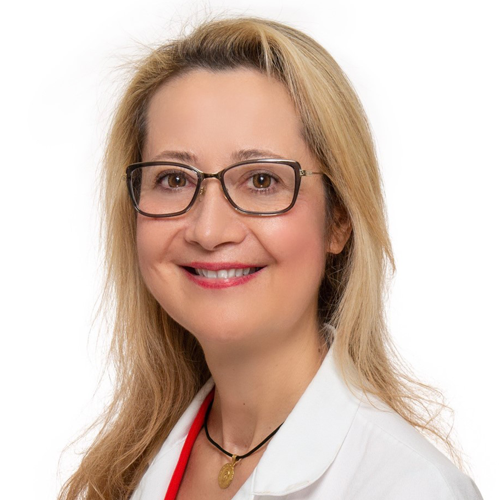
Ourania Preventza, MD
The Department of Surgery’s Division of Cardiothoracic Surgery has an outstanding national reputation for performing the highest-quality cardiothoracic surgery in the state of Virginia. In honor of Heart Health Month, we sat down with Ourania Preventza, MD, MBA, FACS, the George Minor Professor of Thoracic Surgery at UVA Department of Surgery, and Chief of the Division of Cardiothoracic Surgery and Co-Director of Cardiovascular Service Line at UVA Health, to learn about the best ways to take care of your heart.
Dr. Preventza is triple-boarded: American Board of Surgery, American Board of Surgery (Surgical Critical Care), and American Board of Thoracic Surgery and is the immediate past president of the International Society of Endovascular Specialists. In addition to her role at UVA, she is an adjunct professor of surgery at Baylor College of Medicine in Houston and was its first female cardiothoracic surgeon to serve as a professor of surgery with tenure.
Dr. Preventza earned her medical degree from the Medical School of Athens with honors and completed her general surgery residency at Providence Hospital, Michigan — and cardiothoracic surgery residency at Albert Einstein College of Medicine, New York.
Q: What are the top things someone can do to take care of their heart health?
“No smoking. Exercise — and avoid fast food and sugar. Ideally, Mediterranean heart healthy diet with vegetables, fruits, olive oil, nuts, plant-based fats, and more seafood is a great and good start for someone who wants to develop a healthy habit!”
Q: What is TAVR?
“The medical abbreviation for transcatheter aortic valve replacement — a procedure to replace the aortic valve without the patient undergoing an open heart operation. It’s indeed a significant advancement in cardiovascular medicine, providing an alternative for patients who are not suitable candidates for traditional open-heart surgery.
“Another name is TAVI, which stands for transcatheter aortic valve implantation. The first TAVR (TAVI) was performed in 2022 by Alain Cribier, MD, FACC, at Charles Nicolle University in Rouen, France. The procedure is minimally invasive, and it treats a condition called aortic valve stenosis, in which a new valve is inserted without removing the old, diseased valve.
“The aortic valve is the gate keeper between the heart and the aorta — the largest blood vessel in the body. When the heart squeezes, blood flows into the aorta and allows the brain and different organs in the body to receive adequate blood supply to function properly. If the aortic valve becomes too narrow, then the patient has a disease called severe aortic valve stenosis.
“TAVR/TAVI has revolutionized the treatment of aortic valve stenosis, offering a minimally invasive option with shorter hospital stays and quicker recovery times compared to traditional open-heart surgery. The fact that it’s now being considered for low, intermediate, and high-risk patients showcases its expanding utility and effectiveness.
“At UVA Health, we have a range of FDA-approved devices for TAVR/TAVI procedures and our team of cardiovascular surgeons and cardiologists offer options to tailor treatment to individual patient needs — optimizing outcomes. Additionally, many cardiologists and cardiovascular surgeons participate in cardiovascular trials which reflect our commitment to staying at the forefront of research and innovation in this field, leading to further improvements in patient care and outcomes.
“At UVA Health, patients have access to both traditional open-heart surgery and TAVR/TAVI procedures, ensuring each patient receives the most appropriate treatment based on their unique circumstances and risk factors. This approach highlights a patient-centered approach to healthcare, where decisions are made collaboratively between patients and their healthcare teams.”
Q: You’re six months into your roles at UVA Health — how’s it going; what’s your vision?
“UVA Health is positioned to be a beacon of excellence in cardiovascular care, not just within Virginia but also in the wider Atlantic region. Charlottesville’s picturesque setting, along with its proximity to major cities like Washington, D.C., and Richmond, Virginia, makes it an ideal location for a leading healthcare institution. Leveraging this advantageous location, within reach of National Institutes of Health (NIH) and Food and Drug Administration (FDA), along with the talent and expertise of its physicians and healthcare personnel, shows UVA Health can indeed become a statewide powerhouse in cardiovascular care.
“My vision is to provide patient-centric care tailored to the specific needs of individuals, especially considering the varied presentations of cardiovascular disease across different demographics. By offering specialized care that addresses the entire spectrum of cardiovascular conditions, UVA Health can ensure that Virginians have access to world-class treatment without needing to seek care outside the state. It is my philosophy, a patient-centric approach in healthcare, that prioritizes the individual needs, preferences, and values of patients throughout their healthcare journey. It involves actively engaging patients in decision-making, respecting their autonomy, and tailoring care to meet their unique circumstances.
“Our continuous expansion and recruitment of talented individuals to the cardiovascular surgery team demonstrate a commitment to staying at the forefront of advancements in the field. This dedication to excellence undoubtedly will contribute to UVA Health’s reputation as a major referral center and a leader in cardiovascular care in the region and in the wider Atlantic area.
“Overall, my vision for UVA Health to become a statewide powerhouse in cardiovascular expertise is ambitious yet achievable — given the institution’s resources, talent, and commitment to patient care. It’s inspiring to see such dedication to improving healthcare outcomes for the community with a patient-centered approach throughout their healthcare journey.”
